I kept putting off a trip to the Sakuma Bros. farm for many reasons. All of those excuses revolved around money, time and/or time for money. However, as a good li’l tea geek, I’d been doing myself a disservice by not going. After all, it was the only operating tea grower/seller in the Pacific Northwest. Well, the only one that’s been at it for a while, anyway.
Even after meeting Richard Sakuma (the man behind the tea) at two different conventions, I still kept putting a trip further north off. That all changed in the last week of July. Reason: Canadians.
If you’ve never heard of the O5 Tea Bar in Vancouver, B.C., you probably should look ‘em up. Especially if you’re a frequenter of this blog. Their mission statement is akin to mine: To explore strange new teas. They first came to my attention via Twitter. The first thing I noticed was that they carried Korean oolong. The second thing I noticed was a wine cask-aged Nepalese black. I bought both. That tells you all you need to know about them.
The outfit was the brainchild of Pedro Villalon and Brian Noble. Aside from owning and running the tea bar, which has been in business for a year now, they also visited the countries they sourced from. One such location was South Korea, and one of the weird teas they brought back was Tteok-cha. I’ll get back to that. Anywhoozle…
Pedro sent out a request on the O5 Tea Facebook page looking for volunteer tea-pickers. They were heading southward to a tea garden to pick some leaves for experimentation. Naturally, I zapped off an e-mail to Pedro, inquiring about the garden they were picking from. I only knew of two within spitting distance of Vancouver. Pedro replied with, “Burlington.”
My mind whirred. Sakuma!
I told him I’d be happy to volunteer, and that I had a standing invitation to the Sakuma Tea area from Richard. Two birds; one stone. Pedro kindly put me on the list of tag-alongs. Friends James and Allison in Seattle were kind enough to agree to put me up for two days so I could make the long trek to Skagit Valley.
Around 9AM on July 24th, I arrived in the beautiful farm country that was the surrounding area of Burlington. So enamored was I by the entire trip, I’d forgotten two things: To eat, and to tea. I made a stop-thru to a McDonald’s, “caffeinated” with some of their overly-pungent sweet tea, and scarfed down to Egg McMuffins. After that, in true “me”-like fashion, I showed up to the tea garden behind the Sakuma Market Stand…twenty minutes late.
I made the acquaintance of Pedro and Brian, Richard Sakuma again, and the eclectic mix of “Canadians” that volunteered for the jaunt. I say that with very bold air-quotes. Of the cosmopolitan group, there was one Mexican (Pedro) – actually, make that two Mexicans, technically – one San Diegan, one of Irish descent, an Englishman, and a Dutchswedezerlander…heck, I can’t remember. Point being: Yes, they were Vancouverites now, but they were a far-flung enough group that I didn’t feel too out of place in my…uh…’Merican-ness.
On the field, I’ll be honest, I was a lousy tea-picker. On top of having a mean case of Carpal Tunnel Syndrome – thanks to a hard shift at my “day job” prior to the trip – I was also often distracted with asking people questions. Pedro and Richard kindly obliged me and my constant brain-picking. The results of my labors speak for themselves.
For comparison’s sake:
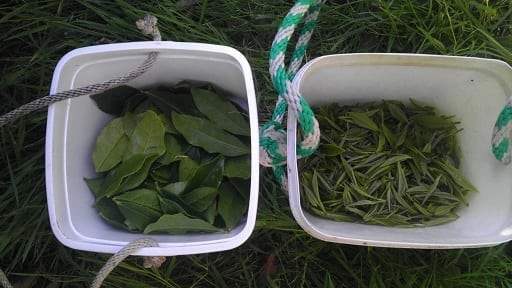
The bucket on the left was mine; the one on the right was someone else’s. Yeah. I have no talent for this.
Once the tea leaf picking phase was done, it was on to Round 2 – making Tteok-cha (or dokk cha) coins. See? I told you I’d get back to that. One of the primary reasons Pedro-‘n-Brian came down to Sakuma was to make tea coins using Northwestern leaves for a truly North American batch. The process was deceptive in its simplicity.
First, they steamed the leaves. Then they took a mortar and pestle and ground the leaves into a paste. After that, the paste was rolled into a ball, put in a plastic film, and stamped flat with a coffee presser-thingy until it was in the shape of a coin. That was it. I was mostly-useless during this phase, so I stood aside and watched others make Tteok-cha magic.
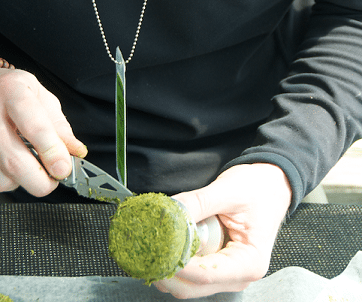
Photo by Ali Lambert
Other leaves after steaming were put through a bit of rolling punishment, Taiwanese-style, for what was to be…
Round 3 was a “cooking” phase of sorts. I have no other way of interpreting it. Richard Sakuma kindly provided a wok to Team O5 for curing and drying the leaves. It was a simple matter of putting leaves in the wok, which was in-turn over a burner. Then they sorted and separated them as they tumbled.
As this was going, I swear the aroma that filled the air smelled like Ali Shan oolong. It was beyond exquisite. Once two baking phases were complete, the leaves were put on mesh sorting mats to dry. The entire tent smelled like the cliffside of a Taiwanese mountain. I would’ve eaten the leaves straight off the mesh if my impulse control were any poorer.

Photo by Ali Lambert
We called it quits once all the leaves were settled. Pedro and Brian told Richard they’d be back the next day to collect their wares. The rest of the volunteer party were northward bound. Me? I could’ve done this for weeks on end. I would’ve been horrible at it, but I would’ve loved every minute of it. Good company helps.
Final thoughts:
(1) Burlington, or someplace like it, is where I want to die. In a rocking chair.
(2) Canadians are as nice as the stereotypes will lead you to believe. Seriously, they put up with me for eight hours.
(3) There’s nothing more fulfilling than picking your own tea.
Because…
‘Merica.
Oh, and ‘Nada, too.
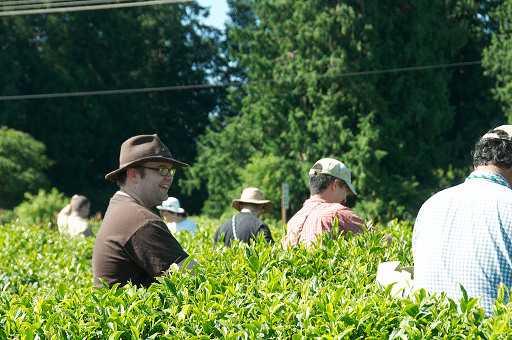
Photo by Ali Lambert
In Memory of Ali Lambert.


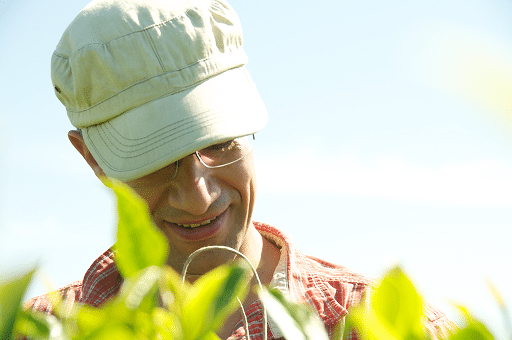
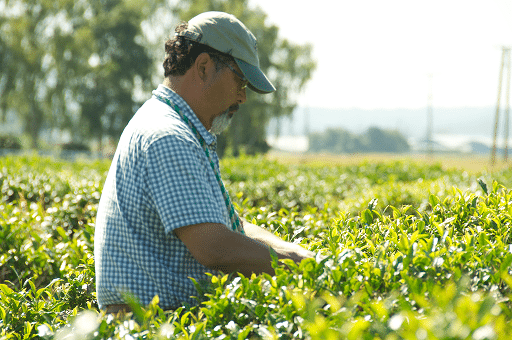
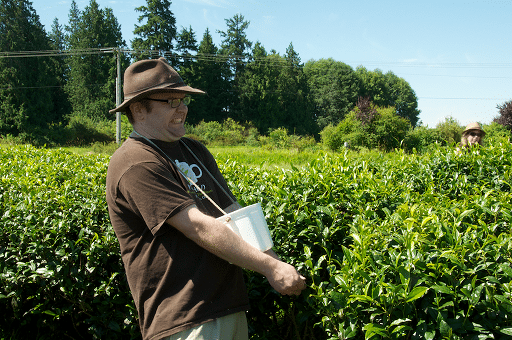
Margo Hutchinson
It is very interesting to learn how the tea is actually made.
lazyliteratus
I probably got some of the terminology wrong, but whatever.
Xavier
Really nice info on picking and tea making.
And for your 3rd point, did you get a batch of it?
lazyliteratus
Nope, but I did pick up some more Sakuma stuff to try. And I got a sweet write-up outta the deal. Win.
Robert Godden
Your title is a factual description of what the blog is about. Virtually unprecedented. Good to see you having a good time..
lazyliteratus
Unprecedented for me? Or unprecedented in general. I do tend to err on the side of hyperbole, true.
Tea adventures are the best adventures.
riccaicedo
I’d love to try a tea coin.
lazyliteratus
You can get ’em here: http://o5tea.com/shop/origin/korea/ddokcha-coins.html
Jackie
Really enjoyed your pics and your report. But I’m a bit confused about the bucket picking comparison pic. Yours on the left looks like standard tea leaves just picked. The ones on the right look different. Perhaps I don’t see the obvious but why is that?
lazyliteratus
@Jackie
The ones on the right were the much-touted two-leaves-and-bud combo. Mine were a pick of older leaves for another experiment.
peter
That goes to show how little we all know about picking tea. What did they use the older leaves you picked for? (or did they laugh at you and call you a knucklehead – or whatever constitutes a friendly Canadian insult?)
I suppose when you think about the two-leaves-and-bud combo, at any given time there probably isn’t a whole of leaf on the tree that can be harvested. I’m sure there is good method to tea picking that we all don’t properly understand.
lazyliteratus
They were originally going to be used for Korean-style dokk cha, but they proved too course and “veiny” for pestling. I know not what became of their fate after that.
bram
We have come a far way from the virgin female tea pickers with the clean nails and their strict diet. I don’t think they were allowed to go to mcdonalds before picking.
lazyliteratus
There’s a white tea in Sri Lanka that’s picked by women that wear gloves. No joke.